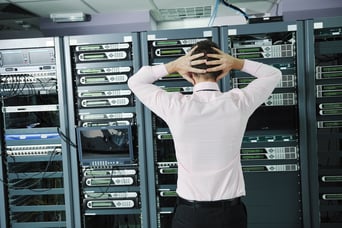
Technology is a massive part of all small businesses in order for them to streamline operations and be competitive in the market. But, when it comes to managing and...
Business continuity and disaster recovery are preemptive plans that guide businesses during a crisis like natural disasters, power outages, technological failure, and cyber incidents. A business continuity plan (BCP) helps you to keep your business running in the face of a crisis while disaster recovery strategies aid you in rapidly restoring your business operations to full capacity following a disaster.
Both these plans go hand-in-hand to cushion the impact of catastrophic events on your business. However, the difference between business continuity and disaster recovery indicates that your business should have both these plans to better deal with disruptive scenarios.
Let's understand what is a business continuity and disaster recovery plan, their importance, must-haves, and distinctions.
A business continuity plan (BCP) lays down the steps on how to continue running business operations when hit with natural calamities, extended power cuts, and cyber intrusions among other catastrophic events. The continuity plan typically contains details about recovery personnel contact information, essential business activities, backup locations, actions to reduce the impact of the disaster, etc.
On the other hand, a disaster recovery (DR) plan focuses on how to respond to natural disasters, power surges, cyber-attacks, and other incidents. Its objective is to quickly restore the company database to bring business activities back to normal after an unfortunate event. Your disaster recovery plan should list all procedures and technologies to resume your business operations as early as possible following a disruptive event.
Business continuity and disaster recovery are interdependent and overlap in many ways. For instance, both are proactive plans to respond to sudden disruptive incidents like cyberattacks and natural disasters to save businesses from losses. Be it BCP or a disaster recovery plan, both require timely review and revision to suit changing business needs.
Nonetheless, a deep dive into business continuity vs disaster recovery will help us determine the difference between business continuity and disaster recovery.
The major difference between business continuity and disaster recovery is the objectives of both these plans. A business continuity plan details how your business can maintain its operations during disasters or cyber intrusions. On the contrary, a disaster recovery plan summarizes how to recover your data, servers, files, software applications, and operating systems in order to restore your business operations back to normal after it is struck by a catastrophe.
These two plans also differ in their functioning. Business continuity is aimed at reducing operational downtime while disaster recovery is focused on repairing affected systems to achieve maximum operational efficiency at the earliest. Moreover, unlike a business continuity plan, disaster recovery planning includes employee safety measures like organizing fire drills and buying equipment to deal with emergencies.
Disruption in business can be a costly affair. IDC estimates that an infrastructure failure costs USD $100,000 per hour on average while a critical application failure can amount to $USD $500,000 to USD $1 million in losses every hour. A business continuity plan will help you minimize downtime and curb losses.
Fiscal losses due to disruptive events also slow down company growth. Businesses might lose critical data during outages which only amplifies the losses. Overall, disruptions damage customer experience harming the bottom line of the business. Disaster recovery acts as a compass guiding businesses to bounce back to normal operations in a short time reducing the impact of a crisis.
A business continuity and disaster recovery plan combined can save your business from significant losses in catastrophic events and help you in better crisis management.
A typical disaster recovery document should include:
We at MicroTech have a proven track record of providing reliable managed IT services for small and midsize businesses for 50 years now. Our IT solutions ensure your business operations are live even when faced with disruptive events like power failures and operating system crashes. Call our IT expert today to get 5-Star rated IT services that power your business 24/7 365 days no matter what!


Technology is a massive part of all small businesses in order for them to streamline operations and be competitive in the market. But, when it comes to managing and...

If you compare the cost of hiring a full-time in-house IT staff and subscribing to remote IT support services you would find that hiring remote IT support for small...